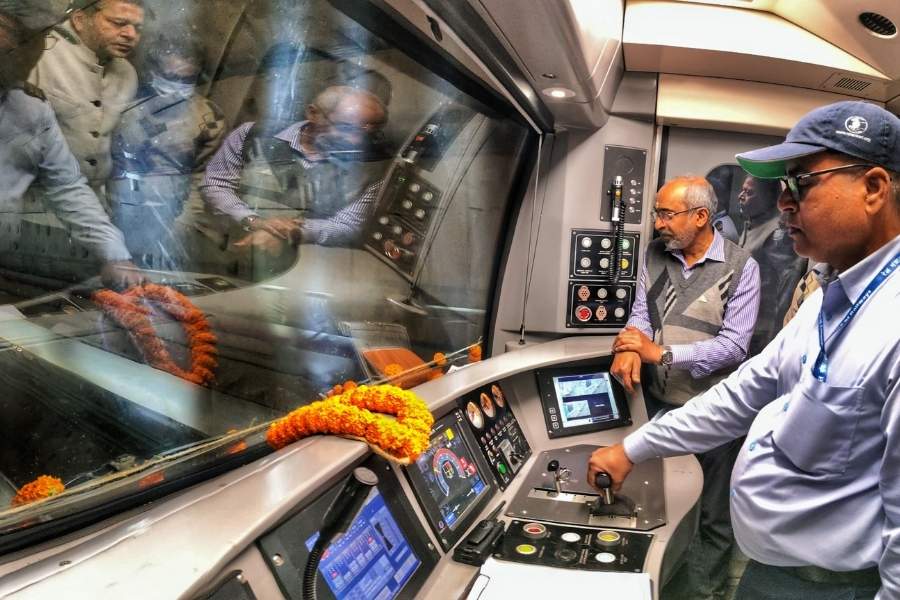 Wednesday, 22 January 2025
Wednesday, 22 January 2025
 Wednesday, 22 January 2025
Wednesday, 22 January 2025
Sandakphu, the highest point of West Bengal, is a magical place. On a clear morning, Kanchenjunga seems within walkable distance. This was from where the first successful team to climb the world's third highest mountain passed. Sandakphu was also where Tenzing Norgay facilitated that team on return in 1955.
Apart from unmatched views of the Sleeping Buddha – with Mt Kumbhakarna making up the head and Mt Pandim the feet of the reclining figure of snow and ice that has Kanchenjunga as its magnificent belly – three more of the world's five highest peaks, Everest, Makalu and Lhotse, dot the horizon.
In this age of “offbeat gems”, Sandakphu is the OG. And tourists with a sense of adventure naturally throng it. But recent deaths have underscored the lack of facilities for the increasing number of people heading there.
Specially with Sandakphu, which is 11,930 feet above sea level, becoming easier to access every day.
Newspaper headlines in Bengal have been asking questions about the lack of medical facilities on the road to Sandakphu. In a million-member Facebook group dedicated to travelling in the Himalayas, it is a topic of discussion.
Lost in the hullabaloo is a question: Is it right to expect "facilities” in a place like Sandakphu?
Sandakphu: A place like no other in India
Sandakphu is the top of the Singalila ridge that the then British rulers bought from the then rulers of Sikkim in 1882. It has been a reserve forest since 1886 and was opened to tourists in 1992 when the Singalila National Park was established.
The road to Sandakphu through this ancient forest begins at Maneybhanjan, which is four hours by road from Bagdogra airport.
The road up to Sandakphu from Maneybhanjan is the de facto border between Nepal and India. While going up, on the right is India and Nepal is on the left for most of the way. The tiny villages – like Chitre, Meghma, Tonglu, Tumling, Kalapokhri, Gairibas – on the way are mostly on the Nepal side.
The border here is porous and the local residents have free movement. Outsiders have to produce id – Aadhaar cards suffice – on the way up as well as down at the numerous Sashastra Seema Bal (SSB) camps on the way.
Only a small number of vintage Series 1 Land Rovers – brought by British tea traders in the 1950s and early '60s and sold off – used to carry men and goods up the trail.
The 32 km ride from Maneybhanjang in the tank-like Land Rovers over what was essentially a hiking trail used to be the stuff of nightmares. It was much better to walk but that took two days at least.
The idea to keep the trail open only to trekkers and Land Rovers – they were originally petrol vehicles – was to control pollution in the pristine forest that is home to rare species such as the red panda, an amazing array of birds and rhododendrons, and predators like binturong, Himalayan black bear and leopards and the super rare clouded leopard.
Not anymore.
The road to Sandakphu has changed
The cars have changed, so has the road to Sandakphu.
The Land Rovers, which are now all diesel engines in the Land Rover frame, are dwindling. There used to be around 50, now there are barely 15 left. Boleros and even Mahindra Thars are increasingly ferrying tourists up to Sandakphu.
Most of the trail to Sandakphu is now a proper tarred road – probably better condition than roads post the monsoons in India’s commercial capital of Mumbai. Last year, the road was metalled till Gairibas. As of May this year, the smooth road extended higher up to near Kalapokhri.
It is now possible to head out from Kolkata early morning, fly into Bagdogra and be in Sandakphu by nightfall.
Possible but foolhardy. Because altitude sickness is one of the most unpredictable things known to man.
The dangers of getting too high too fast
Sandakphu is now the highest one can get to by car at the quickest possible time from a major metro city anywhere in India.
To get to similar altitudes from a big city would take two to three days of travelling anywhere else in the Himalayas.
Ask any doctor and they will tell you what kind of stress the rarefied air of high altitudes coupled with extreme cold put the human body to.
Perfectly healthy individuals can get altitude sickness, which usually starts with a persistent headache and in its worst form does one of two things – swell up the lungs (HAPE or high altitude pulmonary edema) or the brain (HACE or high altitude cerebral edema).
Some reports have said HAPE is suspected in the 28-year-old girl from Kolkata who died this week on the way back after spending the night in Sandakphu.
Altitude sickness usually worsens overnight. Which is why in mountaineering the saying goes, climb high, sleep low. Even if one comes down from Sandakphu to Tumling to stay overnight, you are still above 10,000 feet. And prone to altitude sickness.
Altitude sickness also strikes due to lack of acclimatisation – giving the body the time it needs to adjust to the thin air of high altitudes, including by ramping up production of oxygen-carrying RBC.
And there’s not much one can do when altitude sickness strikes, except to head to lower altitudes as fast as possible and get serious medical help.
It’s not just Sandakphu, either
In the incredibly beautiful Lauterbrunnen valley hike in Switzerland, the 72 waterfalls on the way freeze in winter that burst back into life as the temperature goes up. If you walk there in winter, you will find portions on the trail cut off with rope. With clear avalanche warnings for the exploding ice.
But the Himalayas are not the Alps. Any kid who paid attention in geography class will tell you that. It is perhaps foolish to expect such facilities in the high Himalayas.
India’s rapid modernisation of roads in the high border areas in the Himalayas has also prompted a tourism boom in areas hitherto only adrenaline junkies would dare.
Sandakphu is one of them. The road to Sandakphu is being modernised because it’s a border road. The Land Rover Association in Maneybhanjan was told by the authorities that the road cannot be stopped because it is a matter of national security.
Areas in Ladakh, which are even higher, have also seen tourists falling ill and that is why the Leh district administration started a rule that no one can head out to the higher reaches without two days of acclimatisation in Leh.
Something like that would help more than the “medical certificates” that the authorities in Singalila are considering for allowing tourists up to Sandakphu.
In Sikkim, tourist car operators now have to mandatorily carry oxygen canisters for emergency use. Something like that, coupled with training for the drivers on how to use them, would also help.
Sandakphu is not a viewpoint. It’s an adventure destination
But the bottom line one must remember is that Sandakphu is not Tiger Hill. Sandakphu is at a serious altitude and the cold there is also extreme because it is a mountaintop where howling winds rage.
On the Indian side, constructions are not permitted because it is part of a national park. On the Nepal side there are no such restrictions. So the two hotels bordering on luxury – as one would translate that word in the high Himalayas – even in Sandakphu are on the part of the mountain top that is in Nepal.
On the way the Sandakphu there are very few “shops” – only a few shanties selling everything from momo to rum.
And to such a place are now heading entire families – with old in-laws and little children to boot – and anyone looking for that perfect jaw-dropping photo for social media.
What a soldier told a distraught Bengali father who had brought his seven-year-old daughter to the Indian Army camp just before Gurudongmar lake in Sikkim with breathing problems is pertinent for Sandakphu too: “You must remember, not all places are for everyone.”
So if you want to get to Sandakphu, do your preparation. Stay for two nights in Maneybhanjan before heading up. Consult your doctor before going. Keep emergency medicines. Ideally, get an oxygen can and learn how to use it.
Spend a night in between Manebhanjan and Sandakphu. And then get to the top to gape at the sights fit for gods. Without worry or discomfort.







